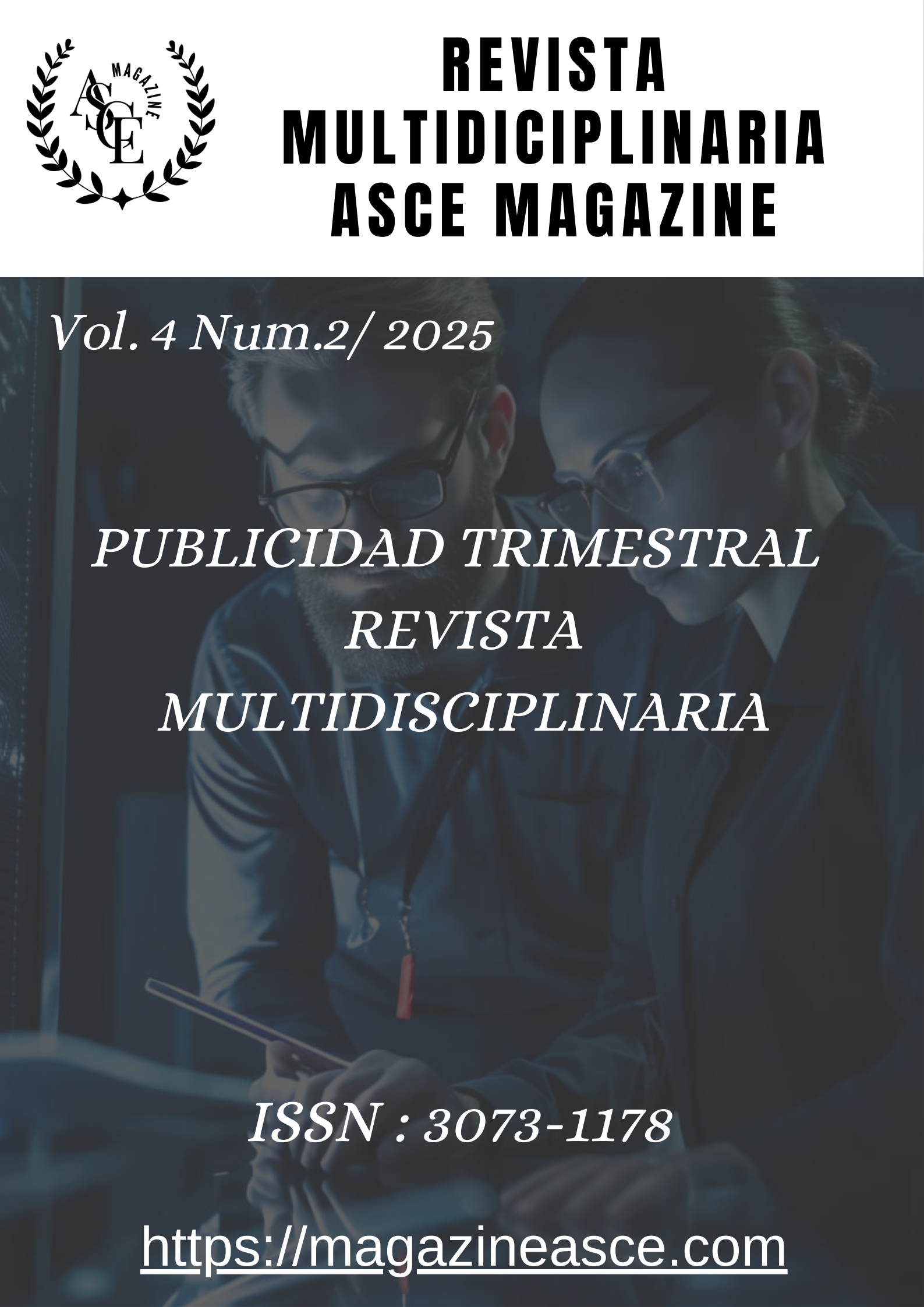Modeling and simulation of complex mechanical systems using principles of applied physics in engineering
DOI:
https://doi.org/10.70577/ASCE/1317.1345/2025Keywords:
mechanical modeling, dynamic simulation, applied physics, complex systems, digital twins, neural networks, computational tools.Abstract
The modeling and simulation of complex mechanical systems play a central role in the development of innovative engineering solutions. This article provides a systematic and analytical review of the state of the art in modeling multicomponent mechanisms, with a focus on integrating applied physics principles and advanced computational tools. The study explores theoretical foundations of dynamic-structural modeling, ranging from Newton's laws and Lagrangian mechanics to material mechanics and vibration theory. It also addresses modern simulation techniques such as modal analysis, inverse kinematics, and multidomain co-simulation. The research identifies key methodological approaches equation-based, data-driven, and hybrid models—as well as the most commonly used tools, including MATLAB, ANSYS, SolidWorks, and Adams. The findings reveal a trend toward hybrid models that combine the precision of physics with the flexibility of machine learning, highlighting approaches such as PINNs, PINODE, and digital twins. Effective validation criteria are discussed, along with persistent challenges such as noise sensitivity, computational scalability, and the faithful representation of complex phenomena. Finally, the study outlines future research directions aimed at enhancing model accuracy, computational efficiency, and practical applicability in real-world engineering contexts.
Downloads
References
Al-Furjan, M. S. H., Fereidouni, M., Habibi, M., Abd Ali, R., Ni, J., & Safarpour, M. (2022). Influence of in-plane loading on the vibrations of the fully symmetric mechanical systems via dynamic simulation and generalized differential quadrature framework. Engineering with Computers, 1-23. https://link.springer.com/article/10.1007/s00366-020-01177-7 DOI: https://doi.org/10.1007/s00366-020-01177-7
Amini, M., Sharifani, K., & Rahmani, A. (2023). Machine learning model towards evaluating data gathering methods in manufacturing and mechanical engineering. International Journal of Applied Science and Engineering Research, 15(2023), 349-362. https://papers.ssrn.com/sol3/papers.cfm?abstract_id=4331917
Bishara, D., Xie, Y., Liu, W. K., & Li, S. (2023). A state-of-the-art review on machine learning-based multiscale modeling, simulation, homogenization and design of materials. Archives of computational methods in engineering, 30(1), 191-222. https://link.springer.com/article/10.1007/s11831-022-09795-8 DOI: https://doi.org/10.1007/s11831-022-09795-8
Cardona, J. P., & Leal, J. J. (2024). Evaluación del desarrollo de habilidades de modelado matemático en un curso de ecuaciones diferenciales ordinarias: un enfoque desde la ingeniería. Formación universitaria, 17(2), 1-14. https://www.scielo.cl/scielo.php?pid=S0718-50062024000200001&script=sci_arttext DOI: https://doi.org/10.4067/s0718-50062024000200001
Choi, Y. K., Kern, N. R., Kim, S., Kanhaiya, K., Afshar, Y., Jeon, S. H., ... & Im, W. (2021). CHARMM-GUI nanomaterial modeler for modeling and simulation of nanomaterial systems. Journal of chemical theory and computation, 18(1), 479-493. https://pubs.acs.org/doi/abs/10.1021/acs.jctc.1c00996 DOI: https://doi.org/10.1021/acs.jctc.1c00996
Csaba, G., & Porod, W. (2020). Coupled oscillators for computing: A review and perspective. Applied physics reviews, 7(1). https://pubs.aip.org/aip/apr/article/7/1/011302/997386 DOI: https://doi.org/10.1063/1.5120412
Cunha, B. Z., Droz, C., Zine, A. M., Foulard, S., & Ichchou, M. (2023). A review of machine learning methods applied to structural dynamics and vibroacoustic. Mechanical Systems and Signal Processing, 200, 110535. https://www.sciencedirect.com/science/article/pii/S0888327023004430 DOI: https://doi.org/10.1016/j.ymssp.2023.110535
Erdemir, A., Mulugeta, L., Ku, J. P., Drach, A., Horner, M., Morrison, T. M., ... & Myers Jr, J. G. (2020). Credible practice of modeling and simulation in healthcare: ten rules from a multidisciplinary perspective. Journal of translational medicine, 18(1), 369. https://link.springer.com/article/10.1186/s12967-020-02540-4 DOI: https://doi.org/10.1186/s12967-020-02540-4
Fu, C., Sinou, J. J., Zhu, W., Lu, K., & Yang, Y. (2023). A state-of-the-art review on uncertainty analysis of rotor systems. Mechanical systems and signal processing, 183, 109619. https://www.sciencedirect.com/science/article/pii/S0888327022007087 DOI: https://doi.org/10.1016/j.ymssp.2022.109619
Ghadami, A., & Epureanu, B. I. (2022). Data-driven prediction in dynamical systems: recent developments. Philosophical Transactions of the Royal Society A, 380(2229), 20210213. https://royalsocietypublishing.org/doi/abs/10.1098/rsta.2021.0213 DOI: https://doi.org/10.1098/rsta.2021.0213
Gao, Y., Liu, X., Huang, H., & Xiang, J. (2021). A hybrid of FEM simulations and generative adversarial networks to classify faults in rotor-bearing systems. ISA transactions, 108, 356-366. https://www.sciencedirect.com/science/article/pii/S0019057820303359 DOI: https://doi.org/10.1016/j.isatra.2020.08.012
Georgopoulos, K., Emary, C., & Zuliani, P. (2021). Modeling and simulating the noisy behavior of near-term quantum computers. Physical Review A, 104(6), 062432. https://journals.aps.org/pra/abstract/10.1103/PhysRevA.104.062432 DOI: https://doi.org/10.1103/PhysRevA.104.062432
Guo, J., Baharvand, A., Tazeddinova, D., Habibi, M., Safarpour, H., Roco-Videla, A., & Selmi, A. (2022). An intelligent computer method for vibration responses of the spinning multi-layer symmetric nanosystem using multi-physics modeling. Engineering with Computers, 38(Suppl 5), 4217-4238. https://link.springer.com/article/10.1007/s00366-021-01433-4 DOI: https://doi.org/10.1007/s00366-021-01433-4
Guo, Y., Wang, X., Shen, Y., Dong, K., Shen, L., & Alzalab, A. A. A. (2022). Research progress, models and simulation of electrospinning technology: A review. Journal of Materials Science, 1-47. https://link.springer.com/article/10.1007/s10853-021-06575-w DOI: https://doi.org/10.1007/s10853-021-06575-w
Kohtz, S., Xu, Y., Zheng, Z., & Wang, P. (2022). Physics-informed machine learning model for battery state of health prognostics using partial charging segments. Mechanical Systems and Signal Processing, 172, 109002. https://www.sciencedirect.com/science/article/pii/S0888327022001807 DOI: https://doi.org/10.1016/j.ymssp.2022.109002
Körner, C., Markl, M., & Koepf, J. A. (2020). Modeling and simulation of microstructure evolution for additive manufacturing of metals: a critical review. Metallurgical and Materials Transactions A, 51, 4970-4983. https://link.springer.com/article/10.1007/s11661-020-05946-3 DOI: https://doi.org/10.1007/s11661-020-05946-3
Legaard, C., Schranz, T., Schweiger, G., Drgoňa, J., Falay, B., Gomes, C., ... & Larsen, P. (2023). Constructing neural network based models for simulating dynamical systems. ACM Computing Surveys, 55(11), 1-34. https://dl.acm.org/doi/abs/10.1145/3567591 DOI: https://doi.org/10.1145/3567591
Lissenden, C. J. (2021). Nonlinear ultrasonic guided waves—Principles for nondestructive evaluation. Journal of Applied Physics, 129(2). https://pubs.aip.org/aip/jap/article/129/2/021101/158329 DOI: https://doi.org/10.1063/5.0038340
Liu, R., Dobriban, E., Hou, Z., & Qian, K. (2022). Dynamic load identification for mechanical systems: A review. Archives of Computational Methods in Engineering, 29(2), 831-863. https://link.springer.com/article/10.1007/s11831-021-09594-7 DOI: https://doi.org/10.1007/s11831-021-09594-7
Liu, X., Huang, H., & Xiang, J. (2020). A personalized diagnosis method to detect faults in gears using numerical simulation and extreme learning machine. Knowledge-Based Systems, 195, 105653. https://www.sciencedirect.com/science/article/pii/S0950705120301039 DOI: https://doi.org/10.1016/j.knosys.2020.105653
Mattsson, S. E., Andersson, M., & Åström, K. J. (2020). Object-oriented modeling and simulation. In CAD for control systems (pp. 31-69). CRC Press. https://www.taylorfrancis.com/chapters/edit/10.1201/9781003067146-2/object-oriented-modeling-simulation-sven-erik-mattsson-mats-andersson-karl-johan-%C3%A5str%C3%B6m DOI: https://doi.org/10.1201/9781003067146-2
Nikolayev, V. S. (2021). Physical principles and state-of-the-art of modeling of the pulsating heat pipe: A review. Applied Thermal Engineering, 195, 117111. https://www.sciencedirect.com/science/article/pii/S1359431121005512 DOI: https://doi.org/10.1016/j.applthermaleng.2021.117111
Norrish, J., Polden, J., & Richardson, I. (2021). A review of wire arc additive manufacturing: development, principles, process physics, implementation and current status. Journal of Physics D: Applied Physics, 54(47), 473001. https://iopscience.iop.org/article/10.1088/1361-6463/ac1e4a/meta DOI: https://doi.org/10.1088/1361-6463/ac1e4a
Papazoglou, E. L., Karkalos, N. E., Karmiris-Obratański, P., & Markopoulos, A. P. (2022). On the modeling and simulation of SLM and SLS for metal and polymer powders: a review. Archives of Computational Methods in Engineering, 1-33. https://link.springer.com/article/10.1007/s11831-021-09601-x DOI: https://doi.org/10.1007/s11831-021-09601-x
Ritto, T. G., & Rochinha, F. A. (2021). Digital twin, physics-based model, and machine learning applied to damage detection in structures. Mechanical Systems and Signal Processing, 155, 107614. https://www.sciencedirect.com/science/article/pii/S0888327021000091 DOI: https://doi.org/10.1016/j.ymssp.2021.107614
Roehrl, M. A., Runkler, T. A., Brandtstetter, V., Tokic, M., & Obermayer, S. (2020). Modeling system dynamics with physics-informed neural networks based on Lagrangian mechanics. IFAC-PapersOnLine, 53(2), 9195-9200. https://www.sciencedirect.com/science/article/pii/S2405896320328354 DOI: https://doi.org/10.1016/j.ifacol.2020.12.2182
Rui, X., Zhang, J., Wang, X., Rong, B., He, B., & Jin, Z. (2022). Multibody system transfer matrix method: the past, the present, and the future. International Journal of Mechanical System Dynamics, 2(1), 3-26. https://onlinelibrary.wiley.com/doi/abs/10.1002/msd2.12037 DOI: https://doi.org/10.1002/msd2.12037
Stern, M., Arinze, C., Perez, L., Palmer, S. E., & Murugan, A. (2020). Supervised learning through physical changes in a mechanical system. Proceedings of the National Academy of Sciences, 117(26), 14843-14850. https://www.pnas.org/doi/abs/10.1073/pnas.2000807117 DOI: https://doi.org/10.1073/pnas.2000807117
Vadyala, S. R., Betgeri, S. N., Matthews, J. C., & Matthews, E. (2022). A review of physics-based machine learning in civil engineering. Results in Engineering, 13, 100316. https://www.sciencedirect.com/science/article/pii/S2590123021001171 DOI: https://doi.org/10.1016/j.rineng.2021.100316
Vasudevan, R., Pilania, G., & Balachandran, P. V. (2021). Machine learning for materials design and discovery. Journal of Applied Physics, 129(7). https://pubs.aip.org/aip/jap/article/129/7/070401/287201 DOI: https://doi.org/10.1063/5.0043300
Wagg, D. J., Worden, K., Barthorpe, R. J., & Gardner, P. (2020). Digital twins: state-of-the-art and future directions for modeling and simulation in engineering dynamics applications. ASCE-ASME Journal of Risk and Uncertainty in Engineering Systems, Part B: Mechanical Engineering, 6(3), 030901. https://asmedigitalcollection.asme.org/risk/article-abstract/6/3/030901/1081999 DOI: https://doi.org/10.1115/1.4046739
Wang, J., Li, Y., Gao, R. X., & Zhang, F. (2022). Hybrid physics-based and data-driven models for smart manufacturing: Modelling, simulation, and explainability. Journal of Manufacturing Systems, 63, 381-391. https://www.sciencedirect.com/science/article/pii/S0278612522000541 DOI: https://doi.org/10.1016/j.jmsy.2022.04.004
Willard, J., Jia, X., Xu, S., Steinbach, M., & Kumar, V. (2022). Integrating scientific knowledge with machine learning for engineering and environmental systems. ACM Computing Surveys, 55(4), 1-37. https://dl.acm.org/doi/abs/10.1145/3514228 DOI: https://doi.org/10.1145/3514228
Yan, B., Harp, D. R., Chen, B., Hoteit, H., & Pawar, R. J. (2022). A gradient-based deep neural network model for simulating multiphase flow in porous media. Journal of Computational Physics, 463, 111277. https://www.sciencedirect.com/science/article/pii/S0021999122003394 DOI: https://doi.org/10.1016/j.jcp.2022.111277
Zhang, L., Zhou, L., & Horn, B. K. (2021). Building a right digital twin with model engineering. Journal of Manufacturing Systems, 59, 151-164. https://www.sciencedirect.com/science/article/pii/S0278612521000455 DOI: https://doi.org/10.1016/j.jmsy.2021.02.009
Zohdi, T. I. (2020). A machine-learning framework for rapid adaptive digital-twin based fire-propagation simulation in complex environments. Computer Methods in Applied Mechanics and Engineering, 363, 112907. https://www.sciencedirect.com/science/article/pii/S0045782520300906 DOI: https://doi.org/10.1016/j.cma.2020.112907
Downloads
Published
How to Cite
Issue
Section
License
Copyright (c) 2025 Julio César Morocho Orellana

This work is licensed under a Creative Commons Attribution-NonCommercial-NoDerivatives 4.0 International License.
Eres libre de:
- Compartir : copiar y redistribuir el material en cualquier medio o formato
- Adaptar : remezclar, transformar y desarrollar el material
- El licenciante no puede revocar estas libertades siempre y cuando usted cumpla con los términos de la licencia.
En los siguientes términos:
- Atribución : Debe otorgar el crédito correspondiente , proporcionar un enlace a la licencia e indicar si se realizaron cambios . Puede hacerlo de cualquier manera razonable, pero no de ninguna manera que sugiera que el licenciante lo respalda a usted o a su uso.
- No comercial : no puede utilizar el material con fines comerciales .
- CompartirIgual — Si remezcla, transforma o construye sobre el material, debe distribuir sus contribuciones bajo la misma licencia que el original.
- Sin restricciones adicionales : no puede aplicar términos legales ni medidas tecnológicas que restrinjan legalmente a otros hacer algo que la licencia permite.





































